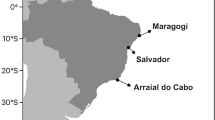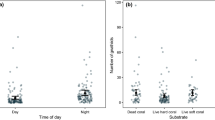Abstract
Mutualisms are pivotal in shaping ecological communities. Iconic images of cleaner fish entering the mouths of predatory fish clients to remove ectoparasites epitomize their mutual benefit. Experimental manipulations of cleaner wrasse reveal declines in fish size and growth, and population abundance and diversity of client fishes in the absence of cleaner wrasse. Fishes grow more slowly and are less abundant and diverse on reefs without cleaner wrasse, both for larger species that are regularly cleaned and have high ectoparasite loads (“attractive species”), and for those smaller species that are rarely cleaned and are rarely infested with parasites (“unattractive species”). We therefore considered whether these previously observed declines in individual and population parameters on reefs without cleaners were related to increased ectoparasite infestation using an attractive species (Hemigymnus melapterus, Labridae) and an unattractive species (Pomacentrus amboinensis, Pomacentridae). Traps with these fish as a form of bait were deployed to sample blood-sucking gnathiid ectoparasites (Gnathiidae: Isopoda) on reefs from which cleaners (Labroides dimidiatus, Labridae) have been removed for 13 yr. Cleaner fish could not enter traps to access the clients/hosts, but gnathiids could enter the traps to infest hosts; thus, this method sampled the indirect effect of cleaners on gnathiid infestation of fish. Infestation was higher on reefs without cleaners than on those with them. The effect was only detected during the daytime when cleaners are active and only on the attractive species (H. melapterus). Thus, cleaner presence indirectly reduced fish exposure to parasites in a species that is highly susceptible to parasites, but not in one that is rarely infested with parasites. This suggests that cleaner presence indirectly reduces exposure of a common fish species to harmful parasites, which may explain some observed benefits in fishes at this location.



Similar content being viewed by others
References
Adlard RD, Lester RJG (1994) Dynamics of the interaction between the parasitic isopod, Anilocra pomacentri, and the coral reef fish, Chromis nitida. Parasitology 109:311–324
Artim JM, Sikkel PC (2013) Live coral repels a common reef fish ectoparasite. Coral Reefs 32:487–494
Bronstein JL (1998) The contribution of ant–plant protection studies to our understanding of mutualism. Biotropica 30:150–161
Bronstein JL (2015) Mutualism. Oxford University Press, New York
Bshary R (2003) The cleaner wrasse, Labroides dimidiatus, is a key organism for reef fish diversity at Ras Mohammed National Park, Egypt. J Anim Ecol 72:169–176
Cheney KL, Bshary R, Grutter AS (2008) Cleaner fish cause predators to reduce aggression toward bystanders at cleaning stations. Behav Ecol 19:1063–1067
Clague GE, Cheney KL, Goldizen AW, McCormick MI, Waldie PA, Grutter AS (2011) Long-term cleaner fish presence affects growth of a coral reef fish. Biol Lett 7:863–865
Coile AM, Sikkel PC (2013) An experimental field test of susceptibility to ectoparasitic gnathiid isopods among Caribbean reef fishes. Parasitology 140:888–896
Côté IM (2000) Evolution and ecology of cleaning symbioses in the sea. Oceanogr Mar Biol Annu Rev 38:311–355
Curtis LM, Grutter AS, Smit NJ, Davies AJ (2013) Gnathia aureamaculosa, a likely definitive host of Haemogregarina balistapi and potential vector for Haemogregarina bigemina between fishes of the Great Barrier Reef, Australia. Int J Parasitol 43:361–370
Del-Claro K, Oliveira PS (2000) Conditional outcomes in a neotropical treehopper–ant association: temporal and species-specific variation in ant protection and homopteran fecundity. Oecologia 124:156–165
Ferreira ML, Smit NJ, Grutter AS, Davies AJ (2009) A new species of gnathiid (Crustacea: Isopoda) parasitizing teleosts from Lizard Island, Great Barrier Reef, Australia. J Parasitol 95:1066–1075
Finley RA, Forrester GE (2003) Impact of ectoparasites on the demography of a small reef fish. Mar Ecol Prog Ser 248:305–309
Gorlick DL, Atkins PD, Losey GS (1987) Effect of cleaning by Labroides dimidiatus (Labridae) on an ectoparasite population infecting Pomacentrus vaiuli (Pomacentridae) at Enewetak Atoll. Copeia 1:41–45
Grutter AS (1995) The relationship between cleaning rates and ectoparasite loads in coral reef fishes. Mar Ecol Prog Ser 118:51–58
Grutter AS (1996) Parasite removal rates by the cleaner wrasse Labroides dimidiatus. Mar Ecol Prog Ser 130:61–70
Grutter AS (1997) Size-selective predation by the cleaner fish Labroides dimidiatus. J Fish Biol 50:1303–1308
Grutter AS (1999) Cleaner fish really do clean. Nature 398:672–673
Grutter AS (2002) Cleaning symbioses from the parasites’ perspective. Parasitology 124:S65–S81
Grutter AS (2003) Feeding ecology of the fish ectoparasite Gnathia sp (Crustacea: Isopoda) from the Great Barrier Reef, and its implications for fish cleaning behaviour. Mar Ecol Prog Ser 259:295–302
Grutter AS, Poulin R (1998) Intraspecific and interspecific relationships between host size and the abundance of parasitic larval gnathiid isopods on coral reef fishes. Mar Ecol Prog Ser 164:263–271
Grutter AS, Bshary R (2003) Cleaner fish prefer client mucus: support for partner control mechanisms in cleaning interactions. Proc R Soc Lond B Biol Sci 70:S242–S244
Grutter AS, Murphy JM, Choat JH (2003) Cleaner fish drives local fish diversity on coral reefs. Curr Biol 13:64–67
Grutter AS, Pickering JL, McCallum H, McCormick MI (2008) Impact of micropredatory gnathiid isopods on young coral reef fishes. Coral Reefs 27:655–661
Grutter AS, Crean AJ, Curtis LM, Kuris AM, Warner RR, McCormick MI (2011) Indirect effects of an ectoparasite reduce successful establishment of a damselfish at settlement. Funct Ecol 25:586–594
Hayes PM, Smit NJ, Davies AJ (2007) Pathology associated with parasitic juvenile gnathiids feeding on the puffadder shyshark, Haploblepharus edwardsii (Voight). J Fish Dis 30:55–58
Hayes PM, Smit NJ, Grutter AS, Davies AJ (2011) Unexpected response of a captive blackeye thicklip, Hemigymnus melapterus (Bloch), from Lizard Island, Australia, exposed to juvenile isopods Gnathia aureamaculosa Ferreira & Smit. J Fish Dis 34:563–566
Jones CM, Grutter AS (2005) Parasitic isopods (Gnathia sp.) reduce haematocrit in captive blackeye thicklip (Labridae) on the Great Barrier Reef. J Fish Biol 66:860–864
Jones CM, Grutter AS (2007) Variation in emergence of parasitic and predatory isopods among habitats at Lizard Island, Great Barrier Reef. Mar Biol 150:919–927
Jones CM, Grutter AS (2008) Reef-based micropredators reduce the growth of post-settlement damselfish in captivity. Coral Reefs 27:677–684
Jones CM, Nagel L, Hughes GL, Cribb TH, Grutter AS (2007) Host specificity of two species of Gnathia (Isopoda) determined by DNA sequencing blood meals. Int J Parasitol 37:927–935
Lafferty KD, Kuris AM (2002) Trophic strategies, animal diversity and body size. Trends in Ecology Evolution 17:507–513
Palmer TM, Pringle EG, Stier A, Holt RD (2015) Mutualism in a community context. Oxford University Press, New York
Penfold R, Grutter AS, Kuris AM, McCormick MI, Jones CM (2008) Interactions between juvenile marine fish and gnathiid isopods: predation versus micropredation. Mar Ecol Prog Ser 357:111–119
Pringle EG, Gordon DM (2013) Protection mutualisms and the community: geographic variation in an ant–plant symbiosis and the consequences for herbivores. Sociobiology 60:242–251
R Development Core Team (2015) R: a language and environment for statistical computing. R Foundation for Statistical Computing, Vienna
Randall JE (1958) A review of the labrid fish genus Labroides, with description of two new species and notes on ecology. Pac Sci 12:327–347
Rohde K (2005) Marine parasitology. CSIRO Publishing, Clayton
Sikkel PC, Ziemba RE, Sears WT, Wheeler JC (2009) Diel ontogenetic shift in parasitic activity in a gnathiid isopod on Caribbean coral reefs. Coral Reefs 28:489–495
Sikkel PC, Sears WT, Weldon B, Tuttle B (2011) An experimental field test of host-finding mechanisms in a Caribbean gnathiid isopod. Mar Biol 158:1075–1083
Smit NJ, Davies AJ (2004) The curious life-style of the parasitic stages of gnathiid isopods. Adv Parasitol 58:289–391
Smit NJ, Grutter AS, Adlard RD, Davies AJ (2006) Hematozoa of teleosts from Lizard Island, Australia, with some comments on their possible mode of transmission and the description of a new hemogregarine species. J Parasitol 92:778–788
Soares MC, Bshary R, Côté IM (2008) Does cleanerfish service quality depend on client value or choice options? Anim Behav 76:123–130
Soares MC, Oliveira RF, Ros AFH, Grutter AS, Bshary R (2011) Tactile stimulation lowers stress in fish. Nat Commun 2:534
Sun D, Cheney KL, Werminghausen J, Meekan MG, McCormick MI, Cribb TH, Grutter AS (2015) Presence of cleaner wrasse increases the recruitment of damselfishes to coral reefs. Biol Lett 11:20150456
Sun D, Cheney KL, Werminghausen J, McClure EC, Meekan MG, McCormick MI, Cribb TH, Grutter AS (2016) Cleaner wrasse influence habitat selection of young damselfish. Coral Reefs 35:427–436
Vaughan DB, Grutter AS, Costello MJ, Hutson KS (2017) Cleaner fishes and shrimp diversity and a re-evaluation of cleaning symbioses. Fish Fish 18:698–716
Waldie PA, Blomberg SP, Cheney KL, Goldizen AW, Grutter AS (2011) Long-term effects of the cleaner fish Labroides dimidiatus on coral reef fish communities. PLoS One 6:e21201
Wagner E, Roche DG, Binning SA, Wismer S, Bshary R (2015) Temporal comparison and predictors of fish species abundance and richness on undisturbed coral reef patches. Peerj 3:e1459
Acknowledgements
We thank S. P. Blomberg for statistical advice, and field assistants and Lizard Island Research Station staff. This work was funded by the Australian Research Council, Sea World Research and Rescue Foundation, Australia, the US National Science Foundation (OCE-1536794, PC Sikkel, PI), and The University of Queensland.
Author information
Authors and Affiliations
Corresponding author
Additional information
Communicated by Biology Editor Dr. Andrew Hoey
Electronic supplementary material
Below is the link to the electronic supplementary material.
Rights and permissions
About this article
Cite this article
Grutter, A.S., De Brauwer, M., Bshary, R. et al. Parasite infestation increases on coral reefs without cleaner fish. Coral Reefs 37, 15–24 (2018). https://doi.org/10.1007/s00338-017-1628-z
Received:
Accepted:
Published:
Issue Date:
DOI: https://doi.org/10.1007/s00338-017-1628-z




